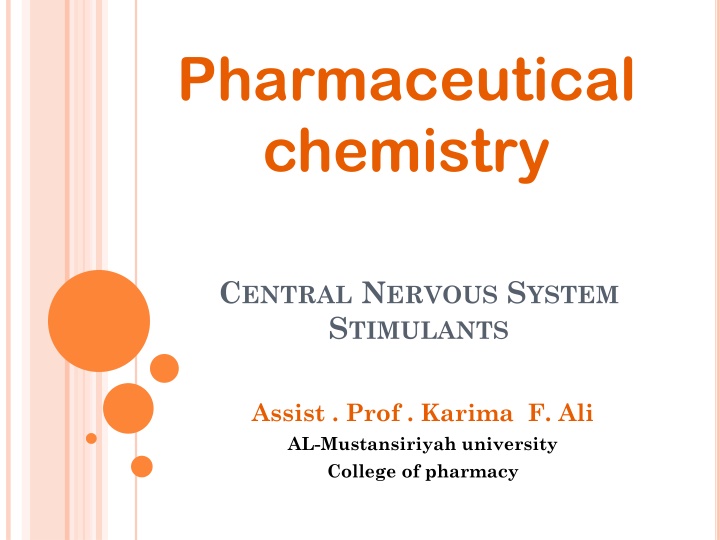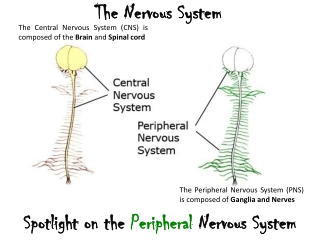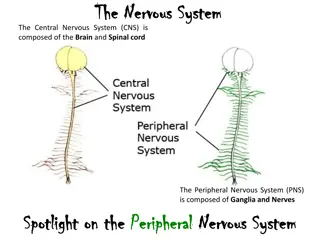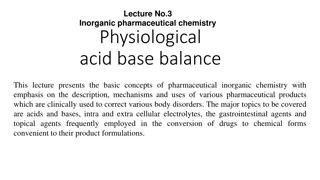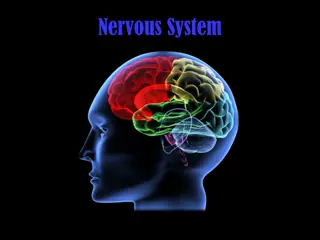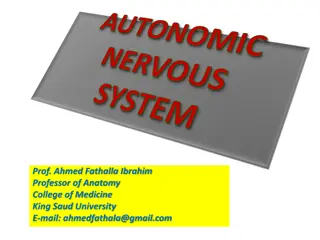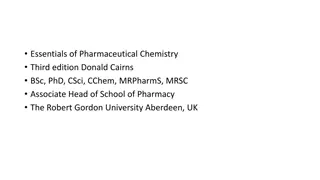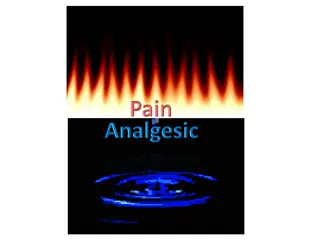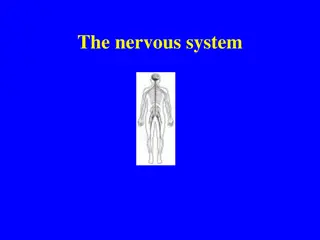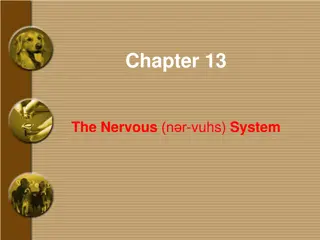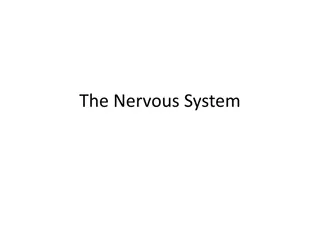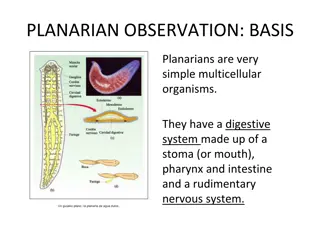Overview of Central Nervous System Stimulants in Pharmaceutical Chemistry
Central Nervous System Stimulants encompass a diverse group of agents with various effects on the CNS, including analeptics, methylxanthines, central sympathomimetic drugs, and antidepressants. Analeptics are potent CNS stimulants with limited use, while methylxanthines like caffeine have widespread stimulatory properties. Modafinil and doxapram are newer selective agents used in narcolepsy and respiratory stimulation, respectively. Theophylline and theobromine also have CNS stimulant properties. These stimulants work by antagonizing adenosine receptors, affecting sleepiness regulation.
Download Presentation

Please find below an Image/Link to download the presentation.
The content on the website is provided AS IS for your information and personal use only. It may not be sold, licensed, or shared on other websites without obtaining consent from the author.If you encounter any issues during the download, it is possible that the publisher has removed the file from their server.
You are allowed to download the files provided on this website for personal or commercial use, subject to the condition that they are used lawfully. All files are the property of their respective owners.
The content on the website is provided AS IS for your information and personal use only. It may not be sold, licensed, or shared on other websites without obtaining consent from the author.
E N D
Presentation Transcript
Pharmaceutical chemistry CENTRAL NERVOUS SYSTEM STIMULANTS Assist . Prof . Karima F. Ali AL-Mustansiriyah university College of pharmacy
Central Nervous system Broad range of agents that stimulate the central nervous system (CNS). 1. The Analeptics classically are a group of agents with a limited range of use because of the general nature of their effects. 2. The Methylxanthines have potent stimulatory properties, mainly cortical at low doses but with more general effects as the dose is increased. 3. The central sympathomimetic Amphetamine and close relatives have alerting and antidepressant properties but are medically used more often as anorexiants. 4. The antidepressant drugs are used most frequently in depressive disorders and can be broadly grouped into the monoamine oxidase inhibitors (MAOIs), agents
the monoamine reuptake inhibitors, and agents acting on auto receptors. 1. Analeptics The traditional analeptics are a group of potent and relatively nonselective CNS stimulants. They can be illustrated by picrotoxinin and pentylenetetrazole. Both are obsolete as drugs but remain valuable determining how drugs act. Newer agents, modafinil and doxapram, are more selective and have use in narcolepsy and as respiratory stimulants. research tools in
Modafinil ( Provigil) It is considered an atypical 1-norepinephrine (NE) receptor stimulant and is used to treat daytime sleepiness in narcolepsy patients. Doxapram Hydrochloride (Dopram) Has an obscure molecular mechanism of action. It stimulates respiration by action on peripheral carotid chemoreceptors. It has use as a respiratory stimulant post anesthetically, after CNS depressant drug overdose, in chronic obstructive pulmonary diseases, and in the apneas.
2. Methylxanthines The naturally occurring Methylxanthines are caffeine, theophylline, and theobromine. Caffeine is a widely used CNS stimulant. Theophylline has some medical use as a CNS stimulant, but its CNS stimulant properties are encountered more often as sometimes severe, and potentially life-threatening, side effects of its use in bronchial asthma therapy. Theobromine has very little CNS activity (probably because of poor physicochemical properties for distribution to the CNS).
The Methylxanthines were once attributed to their phosphodiesterase-inhibiting ability. This action is probably irrelevant at therapeutic doses. Evidence indicates that stimulant action is related more to the ability of these compounds to antagonize adenosine at A1 and A2A receptors. which inhibit sleepiness- inducing adenosine. Problems with the present compounds, such as caffeine and theophylline, are selectivity . CNS-stimulating effects of the the overall CNS- lack of receptor
3. Central sympathomimetic agents (Psychomotor stimulants) Sympathomimetic agents, whose effects are manifested mainly in the periphery, Afew simple structural changes in these peripheral agents produce compounds that are more resistant to metabolism, more non polar, and better able to cross the blood-brain barrier. These effects increase the ratio of central to peripheral activity, and the agents are designated, as central Sympathomimetic agents. In addition to CNS- stimulating effects, manifested as excitation and increased wakefulness, many central sympathomimetics exert an anorexiant effect.
Other central effects, notably dopaminergic and serotoninergic effects, can be operative. Structure activity relationship Structural features for many of the agents can be visualized easily by considering that within their structure, they contain a -phenethylamine moiety, and this grouping can give some selectivity for presynaptic noradrenergic systems. * -Phenethylamine, given peripherally, lacks central activity.. or postsynaptic
1. Branching with lower alkyl groups on the carbon atom adjacent ( ) to the amino nitrogen increases peripheral activity (e.g., amphetamine, presumably by retarding The branching generates a chiral center. 2. The dextro (S)-isomer of amphetamine is up to 10 times as potent as the levo (R)- isomer for alerting activity and about twice as active as a psychotomimetic agent. CNS rather than metabolism).
3. Hydroxylation of the ring or hydroxylation on the -carbon (to the nitrogen) decreases activity, largely by decreasing the ability to cross the blood brain barrier. For example, phenylpropanolamine, with a - hydroxyl (OH), has about 1/100th the ability to cross the blood-brain barrier of its deoxy congener, amphetamine. 4. Halogenation (F, Cl, Br) of the aromatic ring decreases sympathomimetic activity. Other activities may increase.
p-Chloro amphetamine has strong central serotoninergic activity. 5. Methoxyl or methylenedioxy substitution on the ring tends to produce psychotomimetic agents, suggesting tropism for dopaminergic (D2) receptors. 6. N-methylation increases activity (e.g., compare methamphetamine with dextroamphetamine). 7. Di-N-methylation decreases activity . 8. Mono-N substituents larger than methyl decrease excitatory properties, but anorexiant properties. Consequently, some of these agents are used as anorexiants, reportedly with less abuse potential than amphetamine. many compounds retain
Amphetamine Sulfate ( )-1-phenyl-2-aminopropane (Benzedrine), as the racemic mixture has a higher proportion of cardiovascular effects than the dextro isomer. For most medical uses, the dextrorotatory isomer is preferred.
Dextroamphetamine (+)-(S)methylphenethylamine, forms salts with sulfuric acid (Dexedrine) and with phosphoric acids. The phosphate is the more water-soluble salt and is preferred if parenteral administration is required. The dextrorotatory isomer has the (S) configuration and fewer cardiovascular effect than the levorotatory (R)-isomer. Additionally, it may be up to 10 times as potent as the (R)-isomer as an alerting agent and about twice as potent a psychotomimetic agent. Although it is a more potent psychotomimetic agent than the (R)- isomer, it has a better ratio of alerting to psychotomimetic effects.
The major mode of action of dextroamphetamine release of NE from the mobile pool of the nerve terminal. inhibition of uptake, may make a small contribution to the overall effects. The alerting actions relate to increased NE available to interact with postsynaptic receptors ( 1). Central 1-receptor activation has classically been considered the basis for most of the anorexiant effect. The psychotomimetic effects are linked to release of DA and activation of postsynaptic receptors.
D2 and mesolimbic D3 receptors would be involved. Effects on 5-HT systems also have been linked to some behavioral dextroamphetamine. Dextroamphetamine is a strongly basic amine. The -methyl group retards, but does not terminate, metabolism conditions, the bulk dextroamphetamine is alkylation to phenyl acetone and ammonia. Phenyl acetone is degraded further to benzoic acid. effects of by MAO. Under most of a metabolized dose by of N-de
Methamphetamine (+)-1-phenyl-2-methylaminopropane hydrochloride desoxyephedrine (Desoxyn), is the dextroamphetamine. It has more marked central and less peripheral dextroamphetamine. hydrochloride analog N-methyl of action than
Benzphetamine hydrochloride (+)-N-benzyl-N,-dimethylphenethylamine phenyl-2-(N-methyl-N-benzylamine) (Didrex), is N-benzyl substituted methamphetamine. The large (benzyl) N-substituent decreases excitatory properties, in keeping with the general structure activity relationship (SAR) for the group.Anorexiant properties are retained. Classically, amphetamine-like drugs with larger than N-methyl substituents are cited as anorexiant through central - agonism. hydrochloride,(+)-1- propane hydrochloride
Fenfluramine hydrochloride (+)N-ethyl- -methyl-m-(trifluoromethyl) phenethylamine hydrochloride unique in this group of drugs, in that it tends to produce sedation rather than excitation. Effects are said to be mediated principally by central serotoninergic, rather than central noradrenergic, mechanisms. It, too, was withdrawn because of toxicity. (Pondimin), is
4. Antidepressants Monoamine Oxidase Inhibitors Antidepressant therapy usually implies therapy directed against major depressive disorders of the unipolar type and is centered on three groups of chemical agents: A. The MAOIs B. The monoamine reuptake inhibitors C. Auto receptor desensitizers and antagonists.
1. Monoamine Oxidase Inhibitors MAOIs act by of monoamine oxidase, thus preventing the breakdown of monoamine neurotransmitters and thereby increasing their availability. A severe problem associated with the MAOIs Several severe hypertensive responses, some fatal, have followed ingestion of foods high in pressor amines. The clinically antidepressants are inhibiting metabolism of NE and 5-HT. inhibiting the activity useful MAOIS between nonselective
Phenelzine Sulfate Phenelzine sulfate, 2-(phenyl ethyl)hydrazine sulfate (Nardil), is an effective antidepressant agent. It irreversibly inactivates the enzyme or its cofactor, presumably after oxidation to the diazine, which can then break up into molecular nitrogen, a hydrogen atom, and a phenethyl free radical. The latter would be the active species in irreversible inhibition. Phenelzine is one of the few non-selective MAOIs still in widespread clinical use.
Tranylcypromine Sulfate It was synthesized to be an amphetamine analog (visualize the -methyl of amphetamine condensed onto the -carbon atom). It does have some amphetamine-like properties, which may be why it has more immediate CNS-stimulant effects than agents that act by MAO inhibition alone.
2. Monoamine Reuptake Inhibitors The monoamine reuptake inhibitors were a group of closely related agents, the tricyclic antidepressants (TCAs),. Almost all of the agents block neuronal reuptake of NE or 5-HT or both. Reuptake inhibition by these agents is at the level of the respective monoamine transporter via competitive inhibition of binding of the monoamine to the substrate- binding compartment. The net effect of the drug is to increase the level of the monoamine in the synapse. Sustained high synaptic levels of 5-HT, NE, or both appear to be the basis for the antidepressant effect of these agents.
Tricyclic Antidepressants The SARs for the TCAs: There is a large, bulky group encompassing two aromatic rings, preferably held in a skewed arrangement by a third central ring, and three- or, sometimes, two-atom chain to an aliphatic amino group that is monomethyl or dimethyl substituted. The overall arrangement has features that approximate a fully extended trans conformation of the -aryl amines. *An extra aryl bulky group that enhances affinity for the substrate-binding compartment of the transporter. * The dimethyl amino compounds tend to be sedative, whereas the monomethyl relatives tend to be stimulatory. The dimethyl compounds tend toward higher 5-HT to NE reuptake block ratios.
*In the monomethyl compounds, the proportion of NE uptake block tends to be higher and, in some cases, is considered selective NE reuptake. * The compounds have anti cholinergic properties, usually higher in the dimethyl amino compounds. The TCAs are extremely accordingly, very highly tissue bound outside the CNS. Because they have anti cholinergic and noradrenergic effects, both central and peripheral side effects are often unpleasant and sometimes dangerous. lipophilic and,
Imipramine Hydrochloride (Tofranil), Imipramine hydrochloride, 5-[3 (dimethyl amino) propyl]- 10,11-dihydro-5H-dibenzazepine mono hydrochloride Tofranil, is the lead compound of the TCAs mainly affects amines (5-HT, NE, and DA) via the transporters. As is typical of dimethyl amino compounds, anti cholinergic and sedative (central H1 block) effects tend to be marked. The compound per se has a tendency toward a high 5-HT- to-NE uptake block ratio and probably can be called a serotonin transport inhibitor (SERTI).
Metabolic N-demethylation occurs, with a buildup of nor imipramine (or desimipramine). The demethylated metabolite is less anti cholinergic, less sedative, and more stimulatory and is a selective norepinephrine reuptake inhibitor (SNERI) Clomipramine Hydrochloride Clomipramine (Anafranil) is up to 50 times as potent as imipramine in some bioassays. The chloro replacing the H- substituent could increase potency by increasing distribution to the CNS. Clomipramine Hydrochloride
An H-bond between the protonated amino group (as in vivo) and the unshared electrons of the chloro substituent might stabilize a - aryl amine like shape and give more efficient competition for the transporter. The drug is an antidepressant. It is used disorder, an anxiety disorder that may have an element of depression. Amitriptyline Hydrochloride(Elavil) Is one of the most anti cholinergic and sedative of the TCAs. Because it lacks the ring-electron enriching nitrogen atom of imipramine, metabolic inactivation mainly proceeds not at the analogous 2- position but at the benzylic 10-position. Because of the 5- exocyclic double bond, E- and Z-hydroxy isomers are produced by oxidation metabolism. in obsessive compulsive
Amitriptyline Hydrochloride(Elavil) Is one of the most anti cholinergic and sedative of the TCAs. Because it lacks nitrogen atom of imipramine, metabolic inactivation mainly proceeds not at the analogous 2-position but at the benzylic 10-position. Because of the 5- exocyclic double bond, E- and Z-hydroxy isomers are produced by oxidation metabolism. Metabolic N-demethylation nortriptyline is produced, which has a less anti cholinergic, less sedative, and more stimulant action than amitriptyline. Nortriptyline is a( SNERI). the ring-electron enriching occurs, and
Doxepin Hydrochloride (Sinequan, Adapin) Is an oxa congener of amitriptyline, as can be seen from its structure. The oxygen is interestingly placed and should influence oxidative metabolism as well as postsynaptic and affinities. presynaptic binding Doxepin Hydrochloride
The (Z)-isomer is the more active, although the drug is marketed as the mixture of isomers. The drug overall is a NE and 5-HT reuptake blocker with significant anti cholinergic and sedative properties. Another derivatives Amoxapine Maprotiline Hydrochloride
3. Selective Serotonin Reuptake Inhibitors -arylamine like grouping is present, as in the tricyclics, and the compounds can compete for the substrate binding site of the serotonin transporter protein (SERT). As in the tricyclics, the extra aryl group can add extra affinity and give favorable competition with the substrate, serotonin. Many of the dimethyl amino tricyclics are, in fact, SSRIs. Because they are extensively N-demethylated in vivo to nor compounds, which are usually SNERIs, however, the overall effect is not selective. Breaking up the tricyclic system breaks up an anti cholinergic pharmacophoric group and gives compounds with diminished anti cholinergic effects. Overall, this diminishes unpleasant CNS effects and increases cardiovascular safety. Instead, side effects related to serotonin predominate.
Fluoxetine In fluoxetine (Prozac), protonated in vivo, the protonated amino group can H-bond to the ether oxygen electrons, which can generate the aryl amino like group, with the other aryl serving as the characteristic extra aryl. The S-isomer is much more selective for SERT than for NET. The major metabolite is the N-demethyl compound, which is as potent as the parent and more selective (SERT versus NET). (serotonin transporter protein, NE transporter) Therapy for 2 or more weeks is required for the antidepressant effect.
Paroxetine is an antidepressant of the selective serotonin reuptake inhibitor (SSRI) class. In the structure of Paroxetine (Paxil), an amino group, protonated in vivo could H-bond with the CH2 O unshared electrons. A -aryl amine like structure with an extra aryl group results. The compound is a very highly selective SERT. As expected, it is an effective antidepressant and anxiolytic. Paroxetine
Sertraline Inspection reveals the pharmacophore for SERT inhibition. The Cl substituents also predict tropism for a 5- HT system. The depicted stereochemistry is important for activity. of Sertraline (Zoloft) (1S,4S)
Fluvoxamine is a medication which functions as a selective serotonin reuptake inhibitor (SSRI) and 1 Fluvoxamine is used primarily of obsessive compulsive disorder (OCD), and is also used to treat major depressive disorders The E-isomer of fluvoxamine (Luvox) (shown) can fold after protonation to the -aryl amine like grouping. Here, the extra hydrophobic group is aliphatic. receptor agonist. for the treatment disorder and anxiety
Citalopram Citalopram (Celexa) is an antidepressant drug of the selective serotonin reuptake inhibitor(SSRI) class. It is a racemic mixture and is very SERT selective. The N-mono demethylated compound is slightly less potent but is as selective. The aryl substituents are important for activity. The ether function is important and probably interacts with the protonated amino group to give a suitable shape for SERT binding.
Citalopram has one stereocenter, to which a 4- fluoro phenyl group and an N,N-dimethyl-3-aminopropyl group bind. As a result of this chirality, the molecule exists in (two)enantiomeric forms (mirror images). They are termed S-(+)-citalopram and R-( )-citalopram. Only the (S)-(+) enantiomer has the desired antidepressant effect
4. Selective Norepinephrine Reuptake Inhibitors movement of a para substituent of fluoxetine (and relatives) to an ortho position produces a SNERI. Nisoxetine Nisoxetine is a SNERI and is an antidepressant. Most activity resides in the isomer. Nisoxetine
